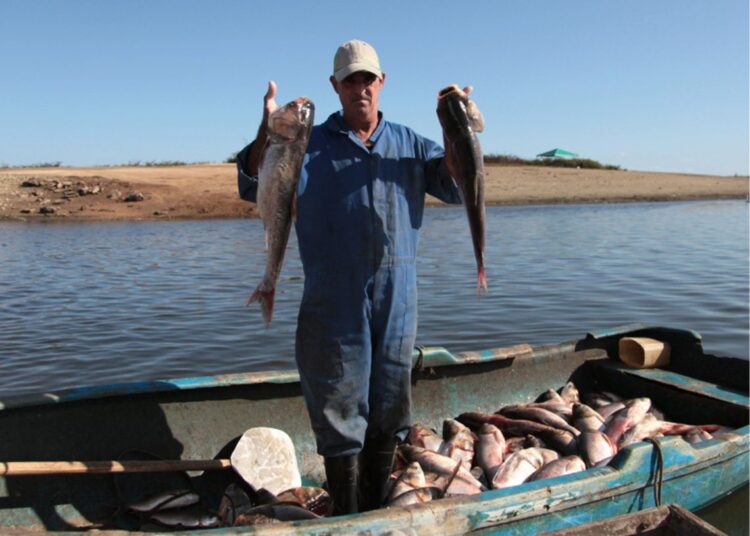More than 500 days have gone by since Deputy Prime Minister Jorge Luis Tapia, speaking before the National Assembly of People’s Power in July 2023, said that aquaculture is “one of the fastest ways to increase the production of animal protein” in Cuba.
By that date, of the 5 kg of animal protein that each Cuban should receive monthly, there had even been a decrease compared to 2022: from 438 grams per inhabitant in that year, it dropped to 347 grams in May 2023.
Although the official statistics for the end of 2023 are not yet published, everything indicates that the “poor use of the capacities of this program” was maintained, as described by Tapia, who, deviating from the text he was reading, called on the population to farm fish in small ponds in their yards.
The “anecdote” is what is most remembered from his appearance, dedicated to describing and evaluating the implementation of the Law on Food and Nutritional Sovereignty and Security, approved by the same parliament in 2022, and which, according to Tapia, did not achieve the “desired effects.”
Paradoxically, this all happened after numerous headlines across the country referred to record production and stocking of fry, pond recovery and international collaboration projects that would necessarily change the face of this sector of the food industry.
In 2016, the IPS news agency reported on the experience of the La Juventud fish farm in Pinar del Río, where the introduction of genetically improved species, the use of good feed and the application of science (injection of hormones to achieve more males than females) predicted a promising future for that unit and the rest of the island. The Ministry of the Food Industry ventured forecasts such as doubling the current catch volume (more than 27,000 tons) by 2030.
It seemed that this would be the case, since in 2018 the same agency reported on a collaboration project with the United Nations Food and Agriculture Organization (FAO), through which genetically improved tilapia would arrive in Cuba from Brazil, thanks to financing of about 300,000 dollars.
In 2020, Las Tunas was forecast to farm 10 million fingerlings and “rescue” bodies of water with no useful value, including 16 hectares in the fish farming center itself. In 2021, the plans in Ciego de Ávila included the rehabilitation of a pipeline and the recovery of 74 ponds, to round out some 2,900 tons of catch.
Two years later, in 2023, Villa Clara took on the same actions as a priority, even though Miguel Díaz-Canel had already indicated in 2019 that aquaculture should be rescued.
In August of this year, in Camagüey, there was talk, at least in plans, of producing 64 million fingerlings ― the highest figure in the country ― to stock all the bodies of water in its territory.
Meanwhile, in Sancti Spíritus ― one of the provinces with the largest catch plan, above 3,000 tons per year ― the local newspaper told the story of a retiree who had queued for days in the vicinity of the fish market and who, finally, had to leave with an empty bag.
Where are the fish?
The authorities have been talking about recovering and rescuing for five years, without fully explaining why the decline in the sector has occurred for a decade. About ten years ago, the highest catches of the four main species of aquaculture in Cuba were made: carp, tench, tilapia and clarias (we exclude white shrimp, produced for export and not for domestic consumption).
These four lines had their peak catch in 2015, with 27,937 tons — according to the all-time series published in the statistical yearbooks — and since then the decline has been sustained, with an annual average of 21,139.2 t in the last decade, but with years below that figure (2019, 2021 and 2022), as shown in the graph.
The data for 2023 do not appear in the Statistical Yearbook for that year, while authorities of the Fishing Industry Business Group ― established in July 2021, with direct subordination to the Council of Ministers and attended by the Ministry of the Food Industry ― have estimated more than 20,000 tons for 2024, which would be around the level of recent times and which has been described (as shown by Cubans’ table) as insufficient.
The arguments put forward point to the financing deficit, the high cost of fry production, and the lack of fuel for the maintenance of the ponds, even though it is recognized that the only way to produce more fish depends more on freshwater than on saltwater.
However, the priority given to this productive branch in the discourse has not been supported by investments in the last decade. From 2012 to 2020, according to statistical yearbooks, less than 20 million pesos were spent annually on construction and assembly in fishing in Cuba ― the lowest values of the total ― which is equivalent to less than 1% of the country’s overall investment structure in each period.
Only since 2021 has more money been allocated (the amounts are still the lowest) to this economic activity that is part of food production, an issue identified as a matter of National Security.
Such shortages led to changes in the national aquaculture strategy, which was able to reach tens of thousands of tons in the previous decade due to intensive production ― a greater quantity of fish in a reduced space ― and not extensive production, an alternative that the government is urging, given the lack of feed, among other inputs.
Recently, Ariel Padrón, Business Director of the Fishing Industry Business Group, commented on the Mesa Redonda TV program that after COVID-19, it has not been possible to intensively cultivate clarias and tilapia, and that the plan is to stock 100% of the country’s dams and micro dams.
These impounded waters require almost 400 million fry, a “large” figure, according to Padrón, which has never been reached. However, in 2023, 308 million were produced, which points to a recovery that can only be verified in 2025, since a carp, for example, takes more than 12 months to reach a kilogram of weight.
This year, a similar production is expected, undoubtedly a good omen judging by the report of the highest audit to the Ministry of the Food Industry, presented by Ramón Osmany Aguilar, president of the agri-food commission of the Cuban Parliament, in its session last July. “It is estimated that industrial production will recover to levels similar to those before the COVID-19 pandemic,” he said.
Although the fry has not yet reached all possible bodies of water, the Fishing Industry Business Group has made its calculations: “If we take stock of what it would be like to reach the maximum stocking of all dams and micro dams and achieve the catches we have on the marine platform, we are talking about the possibility of delivering approximately 5 kg per capita consumption per inhabitant per year,” Padrón said.
The estimate seems to be too optimistic: of 1,250 hectares of earthen ponds to be exploited in Cuba, 500 were still out of service at the end of September.
The source commented that “the progress of this program has as a critical path the low physical availability of diesel fuel, of the resources of the national balance (cement, steel and wood) and the critical situation of the specialized equipment of the construction enterprises.”
In this regard, the report submitted for analysis by the National Assembly insists that 100% of the aquatoria are not being exploited, and adds to the known limitations of the sector the “lack of completion of the fishers’ staff by territories, the need to improve the living conditions of the fishers, not all forms of management are incorporated into this activity and contracts are not fulfilled.”
The impact of droughts and extreme weather events should be added, as well as adaptation to the challenges posed by climate change, for which specific instruments are needed that Cuba has not yet designed, according to the report Assessment of the state of progress of policies and plans for adaptation to climate change in aquaculture in Latin America and the Caribbean (2024), prepared and published by the FAO.
While the miracle of the multiplication of (loaves and) fish remains very elusive, having fish in small ponds in backyards seems a romantic and affordable idea ― to the point of being recommended to Parliament; but no one has explained how citizens, individually and without resources, could achieve on their scale what the State has not achieved on its own.










